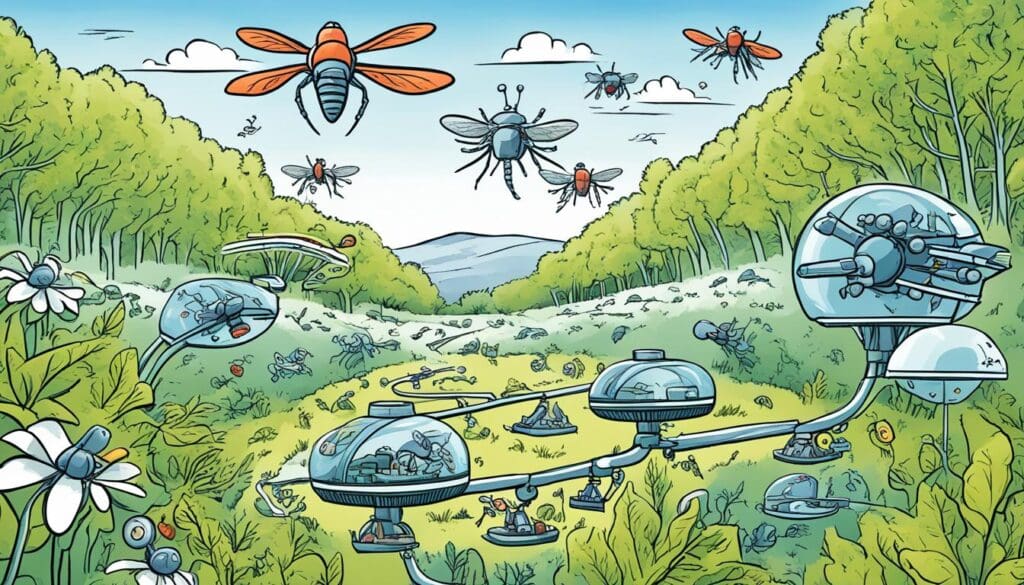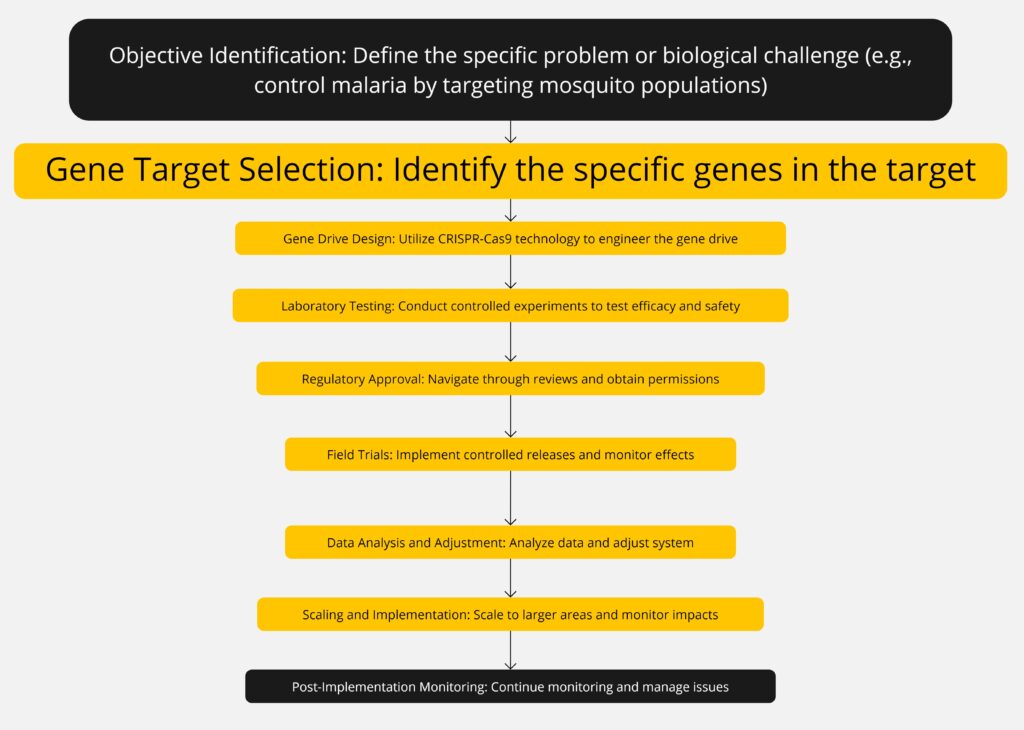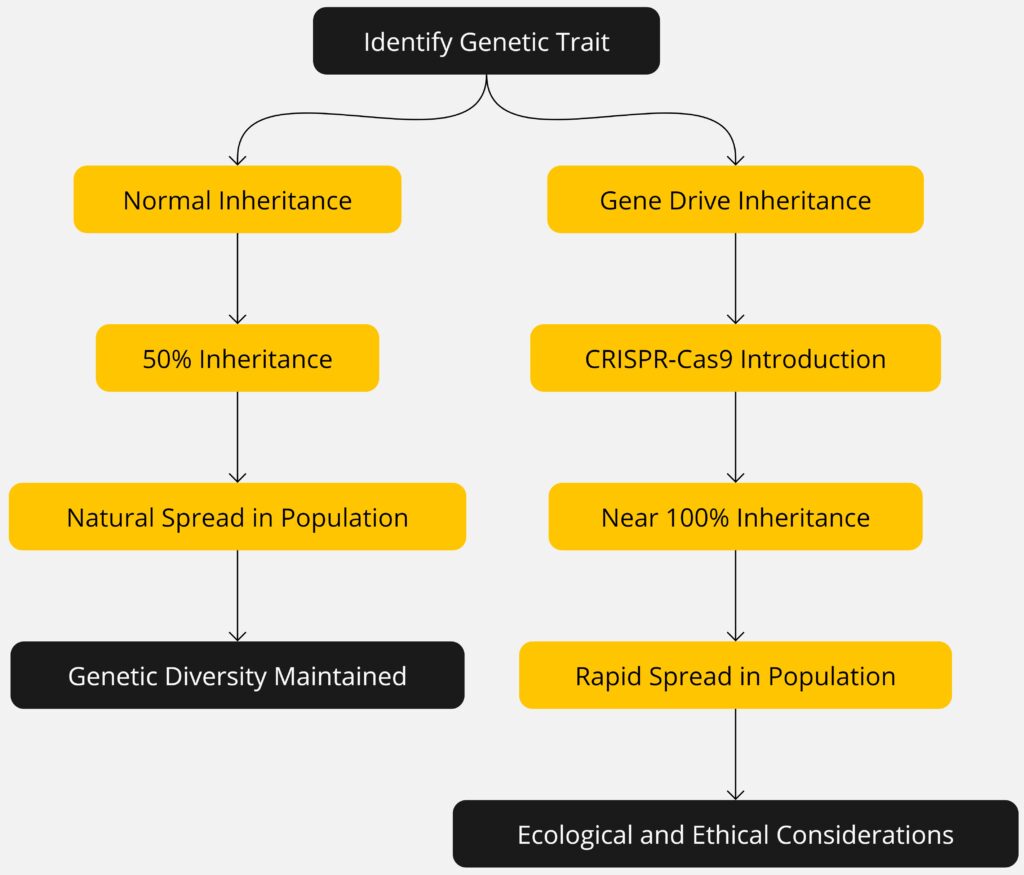Albert Einstein once said, “The world we have created is a product of our thinking; it cannot be changed without changing our thinking.”
Gene Drive Implementation: What, Why, and How
1. What is a Gene Drive? 🧬
- Definition: A gene drive is a genetic engineering technique that promotes the inheritance of a particular gene to increase its prevalence in a population.
- Purpose: It is used to spread specific genetic traits more quickly than would occur under normal Mendelian inheritance.
- Fact: Gene drives can alter entire populations in just a few generations!
2. Why Use a Gene Drive? 🤔
- Disease Control: Used to reduce populations of disease-carrying organisms like mosquitoes.
- Biodiversity Conservation: Helps control invasive species threatening ecosystems.
- Agricultural Benefits: Manages agricultural pests, reducing the need for pesticides.
- Scientific Research: Allows for the study of gene functions in natural populations.
- Trivia: The potential to eradicate diseases like malaria makes gene drives a hot topic in global health discussions.
3. How to Implement a Gene Drive? 🛠️
Step 1: Objective Identification 🎯
- What: Define the specific problem or challenge (e.g., control a disease vector).
- Why: Sets the direction for the project.
- How: Identify target species and desired traits.
- Highlight: Clear goals are crucial for ethical and effective implementation.
Step 2: Gene Target Selection 🧬🔬
- What: Choose the specific gene to modify.
- Why: Ensures the desired outcome is achieved.
- How: Use sequencing and bioinformatics to select the target.
- Fact: The choice of gene can determine the success of the gene drive.
Step 3: Designing the Gene Drive 🛠️🧬
- What: Develop the genetic construct.
- Why: Determines how the gene drive operates.
- How: Use CRISPR-Cas9 to design precise gene editing tools.
- Trivia: CRISPR technology was inspired by a natural bacterial defense system!
Step 4: Molecular Cloning and Vector Construction 🔬
- What: Clone the gene drive into a vector.
- Why: The vector delivers the gene drive to the organism.
- How: Use molecular biology techniques to assemble and verify the construct.
- Highlight: Ensuring the vector is correctly assembled is critical to the gene drive’s success.
Step 5: Laboratory Testing and Optimization 🧪
- What: Test the gene drive in lab settings.
- Why: Assess efficiency and safety.
- How: Introduce the gene drive into cells or model organisms.
- Fact: Laboratory testing helps identify and minimize potential off-target effects.
Step 6: Creating Transgenic Organisms 🐁
- What: Develop organisms carrying the gene drive.
- Why: Establish a stable, inheritable modification.
- How: Techniques like microinjection introduce the gene drive into germline cells.
- News: Researchers have successfully used gene drives in mosquitoes to combat malaria.
Step 7: Regulatory and Ethical Considerations ⚖️🌍
- What: Address legal and ethical issues.
- Why: Ensure safe and responsible use.
- How: Engage with regulatory bodies and conduct risk assessments.
- Highlight: Public engagement and transparency are key to ethical implementation.
Step 8: Field Testing and Monitoring 🏞️
- What: Conduct controlled field trials.
- Why: Test the gene drive in a real-world environment.
- How: Monitor ecological impact and effectiveness.
- Fact: Field trials are crucial for understanding real-world dynamics of gene drives.
Step 9: Data Analysis and Iteration 📊
- What: Analyze data from trials.
- Why: Refine and improve the gene drive.
- How: Use data to make necessary adjustments.
- Trivia: Continuous data analysis helps adapt strategies to changing conditions.
Step 10: Deployment and Long-term Management 🌍
- What: Scale up deployment if successful.
- Why: Achieve widespread application of the gene drive.
- How: Continue monitoring and manage long-term impacts.
- Highlight: Long-term monitoring ensures the gene drive’s benefits outweigh any risks.
This idea is very relevant when we talk about gene drive technology. It’s a genetic engineering tool that could change the game in many areas but also comes with big risks.
Key Concepts and Implications of Gene Drive Technology
| Key Concepts | Implications | Examples |
|---|---|---|
| Gene Drive 🧬 | Rapid spread of genetic modifications through populationsPotential to alter entire species or ecosystems | CRISPR-based gene drives in mosquitoes to combat malaria |
| Ecosystem Modification 🌳 | Ability to suppress or eliminate invasive speciesRisk of unintended ecological consequences | Proposals to control invasive rodents on islands |
| Disease Vector Control 🦟 | Potential to reduce transmission of vector-borne diseasesConcerns about creating ecological voids | Modifying Aedes aegypti mosquitoes to reduce dengue fever transmission |
| Conservation Applications 🌍 | Possibility to protect endangered speciesEthical concerns about altering natural populations | Proposals to increase resilience in coral reefs against climate change |
| Unintended Spread ⚠️ | Risk of gene drives crossing species boundariesPotential for international conflicts due to transboundary spread | Concerns about gene drives in pollen-producing plants affecting related species |
| Reversibility and Control 🛑 | Need for mechanisms to halt or reverse gene drivesChallenges in containing gene drive organisms | Development of “daisy-chain” drives with built-in generational limits |
| Regulatory Challenges ⚖️ | Necessity for international governance frameworksBalancing innovation with precautionary principles | Ongoing debates in UN Convention on Biological Diversity regarding gene drives |
Gene Drive Flow Chart
Gene drive technology could change the way we fight diseases, protect species, and keep crops safe. This is shown in proof-of-concept studies in different organisms. But, releasing gene drive-modified organisms into the wild could have big risks. These risks could harm biodiversity and upset the balance of nature.

Key Takeaways
- Gene drive technology could change how we manage diseases, protect species, and grow crops. But, releasing it into nature could be risky for the environment.
- CRISPR-based gene drives have made progress faster in this area. But, there are still worries about bad effects and not having control over it.
- We need careful management, thorough risk checks, and working together globally to deal with the ethical and legal sides of gene drive technology.
- It’s important to keep things clear, build trust with the public, and understand the differences between natural and engineered gene drives. This helps make good decisions and policies.
- Using gene drive technology wisely is key. We must think carefully about its effects on nature and use it in a controlled and careful way.
Introduction to Gene Drive Technology
Gene drives are new genetic tools that can change how traits are passed down. They don’t follow the usual 50% rule of inheritance. Instead, they use the body’s repair process to make sure almost all offspring get a certain gene. This can quickly change or even wipe out a population.
What is Gene Drive Technology?
Gene drives are genetic tools that break the usual rules of passing traits down. Normally, each child gets half their genes from mom and half from dad. But gene drives use the body’s repair process to make sure almost all offspring get a certain gene. This means they can spread fast, changing or erasing a population quickly.
How Gene Drives Bias Inheritance
Gene drives use CRISPR-Cas tools to make specific cuts in DNA. Then, the body repairs these cuts, copying the gene drive sequence. This makes the modified gene spread quickly through a population.
“Gene drives can be designed to bias inheritance towards 100%, depending on the efficiency of the system.”
The speed at which gene drives spread depends on several factors. These include the gene drive’s fitness cost, the initial release ratio, and how often the organism reproduces. Gene drives could be used to control diseases, pests, or help conservation efforts. But, they also bring up big ethical and environmental questions that need careful thought.
The Promise of Gene Drives
Gene drive technology is a big step forward in solving global problems. Scientists are looking into using gene drives to stop diseases like malaria and Zika by changing mosquitoes. Gene drives could also help control invasive species or give endangered ones a boost to survive.
Gene drives can quickly spread new traits in populations. This could change how we manage diseases, pests, and protect nature. It’s a game-changer for tackling big environmental issues.
Transformative Potential
Gene drives can spread genetic changes fast, beating natural selection. This means we could see traits like:
- Mosquito changes that stop diseases from spreading
- Species that don’t harm native habitats
- Helpful traits in endangered animals, giving them a better chance
With gene drives, scientists and leaders can make big improvements in disease control, pest management, and ecological restoration.
| Application Area | Potential Impact |
|---|---|
| Disease Control | Reduce the spread of diseases through mosquitoes |
| Pest Management | Control invasive species that harm nature |
| Conservation | Help endangered species survive and thrive |
Using gene drives needs careful thought and checks to be safe and right. We must look at the good and bad sides, including ethical concerns, to use this tech wisely.
Comparison between normal inheritance and gene drive inheritance
Environmental Impacts and Risks
The power of gene drive technology comes with big risks. At the molecular level, CRISPR-based editing can cause unintended consequences like genetic mutations. These could have bad effects if they spread in a population. Also, the gene drive might develop resistance, making it less effective or causing new problems.
Molecular Risk Pathways
Using gene drives worries people about molecular risk pathways. The CRISPR-Cas9 system in these drives can lead to unintended mutations or off-target effects. This could cause big problems if these changed organisms get into the wild.
Population and Ecosystem Risk Pathways
At the population and ecosystem level, releasing gene-edited organisms could have big effects. Changing or controlling a species can mess up food webs and ecosystem dynamics. This could lead to the decline of other species and big changes in the environment. There’s a risk that gene drives could cause the extinction of target species or harm to non-target organisms, leading to biodiversity loss and ecosystem disruption.

“Modifying or suppressing a species can disrupt food webs and ecosystem dynamics, leading to the decline of other species and potentially causing cascading effects throughout the broader environment.”
We need careful thought and lots of research to understand and lessen the risks of gene drive technology. Scientists, policymakers, and local communities must work together. This way, we can make sure this powerful tool is used responsibly.
Gene Drive Technology: Promises and Perils for Ecosystems
Gene drive technology is a complex mix of benefits and risks for our planet’s ecosystem balance. It could help control diseases, manage pests, and protect endangered species. But, releasing it could harm biodiversity and our planet’s health. We must think carefully about its use to avoid big problems.
Gene drives make sure a certain trait is passed on to more than half of a population’s offspring. Scientists have used them since the 1940s to fight disease-carrying insects. Recent tests showed they work well, with some mosquitoes changing their traits almost 100% of the time.
But, we worry about how it might affect nature. The IUCN’s group says gene drives could be very harmful, especially in places where many species are already at risk. We need to be very careful and think about the pros and cons before using this technology.
“Building gene drives initially presented challenges in engineering the necessary components; however, the process became more manageable with the development of CRISPR/Cas9 technology.”
We should be careful as we look into using gene drive technology. We must think about keeping our ecosystems balanced and protecting all kinds of life. A careful and thoughtful approach will help us use this technology without harming nature.
Risk Governance Strategies
Gene drive technology is getting more advanced, and researchers are finding ways to lessen its risks. One method is molecular containment. This means making gene drives that can limit or reverse themselves. This is a key way to manage risks.
It’s vital to develop and use gene drive technology safely and securely. This means having strong safety and security steps, like thorough risk checks, safety measures, and watching over the process. Being able to quickly respond to any problems is also key for handling gene drives responsibly.
Molecular Confinement Strategies
Some strategies aim to keep gene drives from spreading too far. Designing gene drives to need a lot of organisms to work or to only work in certain areas are some ways. These methods can lessen the risks of gene-edited organisms getting out of control.
Biosafety and Biosecurity
For gene drive technology, having good safety and security is a must. This means doing detailed risk checks, following strict safety rules, and having strong oversight. Keeping up with safety and security practices can help lower the risks of gene drives and ensure they’re used right.
Risk Analysis Considerations
Figuring out the risks of gene drive technology is hard because it’s complex and uncertain. Since we can’t always know how gene-edited organisms will affect the environment, risk assessments need to be very thorough and flexible. Making good decisions is also crucial, as we can’t have all the information before we act. This makes the decision-making process very important for using gene drives safely and wisely.
As gene drive technology gets more developed and might be used more, having good risk management strategies is key. By using molecular containment, strong safety and security steps, and detailed risk analysis, researchers and policymakers can try to reduce risks. This way, they can also make the most of this new technology.
Applications of Gene Drive Technology
Gene drive technology is a game-changer for fighting diseases, managing pests, and saving endangered species. Scientists are finding new ways to use this genetic tool to solve big problems.
Disease Control
Gene drives could be a game-changer for fighting diseases spread by mosquitoes. By changing mosquitoes, we might stop diseases like malaria and Zika. Nearly two hundred million people get malaria every year, and it costs a lot of money to fight it. This tech could be a new way to fight this big health issue.
Pest Management
Gene drives could also help with pests like the diamondback moth and fruit flies. In Asia, rats eat over 30 million tons of rice each year, feeding 180 million people less. In Australia, rats hurt the country’s crops by 3 to 4% in bad years. Using gene drives could make farming more sustainable and effective.
Conservation and Ecological Restoration
Gene drives could also help protect endangered animals and fix damaged ecosystems. Researchers want to use them to save species and balance out nature. Invasive rodents are killing many birds by eating their babies and eggs. Gene drives could control these pests and help native wildlife come back.
As scientists improve gene drive technology, we see more ways it can help. But, we also need to think about the ethics and environmental impact. We must do thorough research, talk openly, and have strong rules to use this technology right.

Ethical and Social Implications
The creation and use of gene drive technology bring up big ethical concerns and social impact. People worry about the possible bad effects, the fact that some gene drives can’t be turned back, and who gets to use this tech. It’s key to talk with stakeholders to make sure gene drives are used right and ethically.
The Precautionary Principle (PP) might shape how we regulate new tech like CRISPR-Cas9. This rule says we should avoid possible dangers. Some think it slows down progress. Others suggest a step-by-step approach that changes as we learn more.
Design ethics and participative design focus on keeping human values in mind when making new tech. The Collingridge dilemma points out the need to act early, as it gets harder to change a technology’s effects later on.
“The unpredictability of evolved systems poses challenges for controlling gene drive organisms, as they may mutate over time.”
Talking to different stakeholders, like local communities, is key to tackle the ethical concerns and social impact of gene drives. This way, we can make sure everyone has fair access and it’s used wisely.
Global Governance of Gene Drives
Gene drive technology is growing, with big impacts on ecosystems worldwide. It needs strong international rules and global coordination. This tech can change species, bringing up complex issues that call for international teamwork and oversight.
The Need for International Regulations
Since gene drives work across borders, we need a strong system of international rules. These rules should set clear guidelines for biosafety, thorough risk assessment, and risk management plans. They also need to help countries work together and share information.
We need global coordination to use gene drives safely, sustainably, and fairly. This means creating international standards, making rules work together, and keeping everyone informed and working together.
- Set strong biosafety rules to lower the risk of bad environmental effects.
- Use full risk assessment and management plans to deal with possible effects across borders.
- Help countries work together and share information to spread knowledge and best practices.
- Create international standards and similar rules to make sure gene drive use is responsible and fair.
By tackling the global governance issues of gene drive, we can use its benefits safely. This protects ecosystems and communities all over the world.
“Coordinated global efforts are necessary to ensure the safe, sustainable, and equitable use of gene drives across national boundaries.”
Conclusion
Gene drive technology could be a big help in solving global problems. But, we need to be very careful because it could also cause big risks. We must find a good balance between its benefits and dangers.
This means we need strong rules and careful planning. We should use things like molecular confinement and strict safety checks. Also, working together on a global scale is key.
Doing more research and talking with different groups is important. We must keep focusing on making things better for our planet. By using gene drive technology wisely, we can lessen the risks and make the most of its potential.
We must always be careful and work together. This way, we can use gene drive technology for good. It’s about looking out for our planet and making sure it’s safe for everyone.
FAQ
What is gene drive technology?
Gene drive technology is a powerful tool in genetic engineering. It can change the traits of entire species and populations. It spreads modified genes quickly through a population by biasing their inheritance.
How do gene drives bias inheritance?
Gene drives use CRISPR-Cas tools to make precise cuts in DNA. Then, they repair these cuts with the gene drive sequence. This makes the modified gene almost certain to be passed on to offspring.
What are the potential benefits of gene drive technology?
Gene drives could help control diseases, invasive species, and aid conservation. They can spread desired genetic changes quickly through populations.
What are the environmental risks of gene drive technology?
Gene drives could cause unintended mutations and harm ecosystems. They might disrupt food chains and lead to the decline of species, affecting the environment greatly.
How can the risks of gene drive technology be mitigated?
Researchers are finding ways to lessen the risks. They’re working on gene drives that can limit themselves or be turned off. They’re also designing drives that only work in certain areas or need a certain number of organisms to activate.
What are the key considerations for the risk governance of gene drive technology?
To safely develop and use gene drives, we need strong safety and security steps. This includes thorough risk assessments, containment, and oversight. It’s also vital to monitor and quickly respond to any problems.
What are some of the applications of gene drive technology?
Researchers aim to use gene drives to fight diseases spread by vectors, control invasive species, and protect endangered species. They also want to restore ecological balance.
What are the ethical and social considerations surrounding gene drive technology?
There are worries about unintended effects, the irreversibility of some uses, and fair access to the technology. It’s important to involve different groups in decisions to use gene drives responsibly and ethically.
Why is global governance of gene drive technology important?
Gene drives could affect many countries, so we need strong international rules. This includes setting safety protocols, risk management strategies, and ways for countries to work together and share information.
Source Links
- https://link.springer.com/article/10.1007/s11569-023-00439-0 – Gene Drives as Interventions into Nature: the Coproduction of Ontology and Morality in the Gene Drive Debate – NanoEthics
- https://www.harvardmagazine.com/node/52676 – Gene drives promise unprecedented human control of the environment | Harvard Magazine
- https://www.epfl.ch/research/domains/irgc/wp-content/uploads/2022/12/IRGC-2022-Gene-drives_Environmental-impacts-sustainability-and-governance.pdf – PDF
- https://food.berkeley.edu/wp-content/uploads/2020/07/2019_Montenegro-de-Wit_Gene-driving-the-farm_-who-decides-who-owns-and-who-benefits_.pdf – PDF
- https://www.genedrivegovernance.org/resources – Resources — Gene Drive Governance
- https://www.nature.com/articles/s41467-023-41727-3 – Engineered and natural gene drives: mechanistically the same, yet not same in kind – Nature Communications
- https://cnr.ncsu.edu/news/2019/06/genetic-engineering-planets-biodiversity/ – Can Genetic Engineering Save Our Planet’s Biodiversity?
- https://www.ncbi.nlm.nih.gov/pmc/articles/PMC11234912/ – Genes drive organisms and slippery slopes
- https://www.sciencedirect.com/topics/biochemistry-genetics-and-molecular-biology/gene-drive – Gene Drive – an overview
- https://www.barrons.com/news/scientists-debate-promise-peril-of-tweaking-wild-genomes-01631354408 – Scientists Debate Promise, Peril Of Tweaking Wild Genomes
- https://www.sciencenews.org/article/gene-drives-spread-their-wings – Gene drives spread their wings
- https://www.ncbi.nlm.nih.gov/pmc/articles/PMC7025691/ – Considerations for the governance of gene drive organisms
- https://www.sciencedirect.com/science/article/abs/pii/S0301479722000536 – Stakeholder engagement to inform the risk assessment and governance of gene drive technology to manage spotted-wing drosophila
- https://www.mdpi.com/2813-0464/2/1/6 – Gene Drive: Past, Present and Future Roads to Vertebrate Biocontrol
- https://www.newyorker.com/news/daily-comment/the-perils-and-promises-of-gene-drive-technology – The Perils and Promises of Gene-Drive Technology
- https://www.ncbi.nlm.nih.gov/pmc/articles/PMC9197202/ – Gene drive communication: exploring experts’ lived experience of metaphor use
- https://www.ncbi.nlm.nih.gov/pmc/articles/PMC9243845/ – Ethical, Legal and Social Implications of Emerging Technology (ELSIET) Symposium
- https://www.buffalo.edu/ubnow/stories/2016/10/mitchell-lecture.html – Forum to tackle new issues in gene editing
- https://watershedsentinel.ca/articles/gene-drives-engineering-the-wild/ – Gene Drives – Engineering the Wild | Watershed Sentinel
- https://www.geneconvenevi.org/tag/gene-drive-opinion/ – gene drive opinion Archives • GeneConvene Virtual Institute
- https://ges.research.ncsu.edu/publications/ – Genetic Engineering and Society (GES) Center
- https://www.ncbi.nlm.nih.gov/books/NBK379267/ – Summary – Gene Drives on the Horizon
- https://www.nature.com/articles/s41576-021-00386-0 – Gene drives gaining speed – Nature Reviews Genetics
- https://www.frontiersin.org/journals/environmental-science/articles/10.3389/fenvs.2023.1254219/full – Frontiers | Gene drives, mosquitoes, and ecosystems: an interdisciplinary approach to emerging ethical concerns



